Panama. The Black Christ of Portobelo.
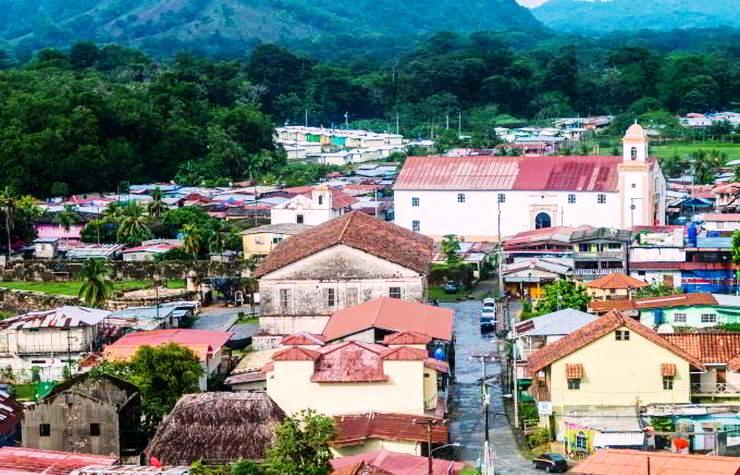
Every year, on October 21, tens of thousands of pilgrims travel to Portobelo, a fishing town in Panama, to pray to the black-skinned, sad-eyed Christ who captivates everyone with his gaze.
On October 21, 1658, one of the three legends about the origin of the Cristo Negro de Portobelo began: a ship coming from distant Spain landed in Portobelo, a Spanish colonial city located in a beautiful bay.
Among the many other objects carried by the ship, there was also a religious image: the figure of Christ carved in black wood.
It was a simple stopover, a short stay, probably to stock up on supplies, since the ship had to continue to other territories of Spanish America, perhaps Colombia or Peru.
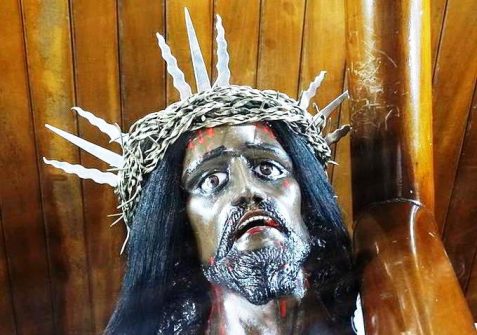
Cristo Negro (Black Christ) in the church San Felipe in Portobelo. The Afro-descendants identified with the dark-skinned, sad-eyed Christ, who united everyone with his gaze. CC BY-SA 2.0/Adam Jones
However, when the ship was finally about to set sail, a terrible storm broke out and forced it to remain moored in the bay.
Attempts to set sail followed one another, but they were all fruitless because every time the ship tried to set sail, a new storm broke out with thunder, lightning and torrential rain. And everyone surrendered to the evidence. It was a powerful sign from heaven, a divine message: the Black Christ had arrived in Portobelo and wanted to stay. The local Afro-descendant population, who had been deported from Africa at the beginning of the 16th century when the Kingdom of Spain had banned the slavery of Native Americans, immediately identified with that dark-skinned, sad-eyed Christ, who united everyone with his gaze.
Other legends about the Black Christ
A second legend tells that the wooden image of the Black Christ was found by a slave fisherman. The fisherman noticed a boat drifting in the bay of Portobelo with a large wooden box inside. He thought that a ship had thrown it overboard to get rid of excess cargo and was very surprised to discover inside it the image of a Christ with skin as dark as his. At the time, a cholera epidemic was claiming many victims. By turning to the Black Christ, the patients miraculously recovered. Legend also says that when the Spanish learned of the rescue of the image and the miracles, they wanted to send it to another location far from Portobelo but repeated storms prevented the Black Christ from leaving the village of fishermen, mostly of African origin.
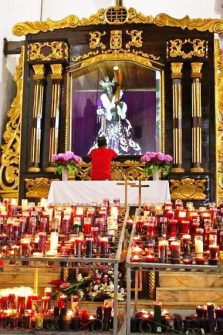
The adoration of Cristo Negro at the Iglesia de San Felipe. Real changes occur in the hearts of the pilgrims. CC BY-SA 3.0/Daniestrada01
A third legend says that the arrival of the Black Christ in Portobelo was the result of a mistake. Two religious sculptures had been ordered from Spain: St. Peter for the city of Portobelo and the Black Nazarene for the city of Taboga. However, upon disembarkation in Portobelo, there was a mix-up and the statue of Christ remained there, being installed in the church of San Felipe. The church was destroyed ten years later, in 1688, by an English pirate. A new temporary wooden church was built that served as a parish until 1780. In 1796, work began on the current church, which was completed in 1815. In 1928, it was declared a national historic monument. The bell tower was added in 1945.
The Black Christ Procession
The procession begins at sunset on October 20 and ends at midnight on the 21st, with the return of the Black Christ to the Church of San Felipe. Starting on the 15th, tens of thousands of devotees from various parts of Panama head to Portobelo. All pilgrims wear a purple habit, just like the one worn by the Black Christ and they do penance.
Some walk barefoot, others walk long stretches of road on their knees or crawling. Around the Church of San Felipe, whose facade is also painted purple and white and which is illuminated at night with purple spotlights, there are stalls selling scapulars, rosaries, crosses, candles and even T-shirts in honour of the Black Christ of Portobelo.
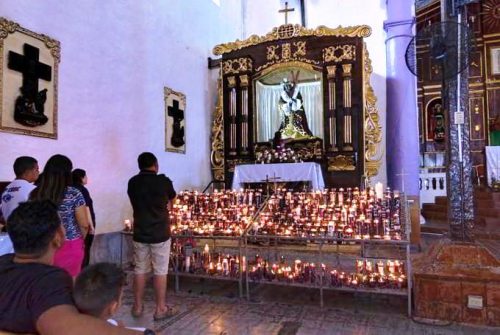
Inside San Felipe Church.CC BY-SA 2.0/ Dan Lundberg
Other stalls offer food and natural juices, as well as Panamanian craft products. The city is pervaded by a pious spirit and a festive atmosphere. Children, young people, adults and the elderly gather in the main square of the city or go to the church of San Felipe to light a candle to Christ the Redeemer and pray with devotion. Mothers and fathers take their children by the hand and lead them to see the Nazarene.
In this way, devotion is perpetuated from generation to generation. On October 20, the image of Christ is removed from the shrine and placed on the processional trolley while still inside the church. On the 21st, the black Christ is carried in procession through the streets of the small Caribbean city by devotees who carry him on their shoulders. The rhythm of the procession is that of the Afro-religious march: they move from one side to the other with three steps back and four forward.
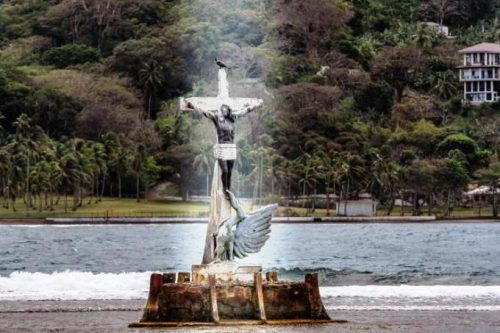
The Black Christ statue rises from the sea off the coast of Isla Grande, also known as Big Island, near Portobelo. Shutterstock/Marek Poplawski
The crowd of faithful acclaim their Christ with songs and prayers and are moved to tears at the sight of the dark-skinned Nazarene walking through the streets where the echo of the songs of the African slaves dragged by force still resounds.
The Latin American people live their piety as a real encounter, individual, family or group, with the person or saint represented in the image. That is why, when the image of the Black Christ is brought back to the church of San Felipe, real changes occur in the hearts of the pilgrims. (Open Photo: Portobelo village as seen from above. 123rf)
Fernando Félix



